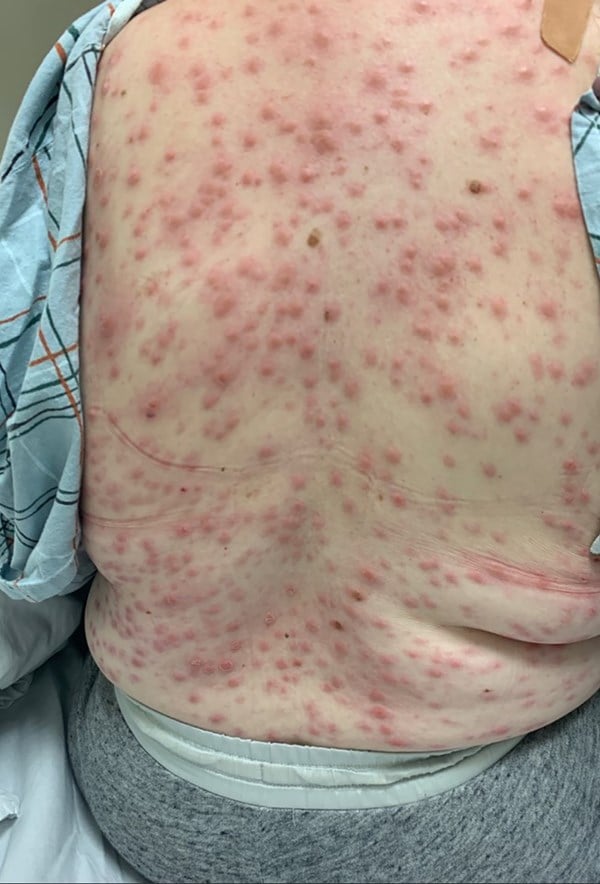A 42-year-old female with a history of bipolar disorder and genital herpes presents with a diffuse rash for 1 month. She reports the rash is red, nonpruritic, and nontender. It started on her chest and spread to now involve her face, trunk, extremities, palms, and soles.
She endorses associated diffuse joint pain as well as fevers, sore throat, nausea, vomiting, mild headache, and intermittent blurred vision. Current medications include clonazepam, haloperidol, and clozapine without recent changes. She is sexually active with multiple partners.
Physical exam is notable for a diffuse non-blanching papular rash, lateral tongue ulceration, and minimally reactive pupils to light and accommodation. There are no genital lesions and her neurological exam is otherwise unremarkable.
What is your diagnosis?
Visual Diagnosis: Syphilis
Her ED presentation was concerning for secondary, and possible tertiary, syphilis with neurologic manifestations. She had biopsy results from a week prior that confirmed a syphilitic rash. HIV testing was negative. Rapid plasma reagin test (RPR) was reactive, as well as serum fluorescent treponemal antibody absorption test (FTA-ABS). Cerebrospinal fluid Venereal Disease Research Laboratory (VDRL) tear was negative. Ophthalmologic examination was negative for ocular complications of syphilis. The patient was treated for secondary syphilis and discharged to follow up as an outpatient.
Discussion
Syphilis is a sexually transmitted infection caused by the spirochete Treponema pallidum and is known clinically to be “the great pretender” or “imitator.”1 Syphilis is categorized into 4 stages: primary, secondary, tertiary, and latent.1 Primary syphilis is characterized by a painless chancre1. Secondary syphilis develops weeks later and includes a papulosquamous rash that can involve the palms and soles.1-3 This stage can also have systemic symptoms of sore throat, malaise, fever, and headaches.2 Tertiary syphilis occurs years later and can involve multiple organ systems, notably the nervous and cardiovascular systems.2 Latent syphilis indicates positive testing without clinical manifestations. This is further subdivided into early latent phase if infection occurred within the past 12 months and late latent phases if infection occurred more than 12 months prior.2
Treatment
Primary, secondary, and early latent stages of syphilis are treated with a one-time intramusuclar dose of penicillin G benzathine, 2.4 million units.3 Doxycycline 100 mg BID for 14 days can be used as an alternate therapy if patients have penicillin allergies. 3 Pregnant women that have penicillin allergies require desensitization.3 Late latent syphilis, latent syphilis of unknown duration, or tertiary syphilis with normal CSF studies should be treated with intramusuclar penicillin G benzathine, 2.4 million units weekly for 3 weeks.3 Neurosyphilis and ocular syphilis are treated with parenteral/aqueous crystalline penicillin G 3-4 million units every 4 hours (18-24 million units per day) for 10-14 days.3 Repeat serologic testing should be done to ensure improvement.3
References
- Serrano KD. Sexually Transmitted Infections. In: Tintinalli JE, Ma O, Yealy DM, Meckler GD, Stapczynski J, Cline DM, Thomas SH. eds. Tintinalli's Emergency Medicine: A Comprehensive Study Guide, 9e New York, NY: McGraw-Hill.
- CDC. STD Facts - Syphilis (Detailed). Retrieved May 5, 2020.
- CDC. 2015 Sexually Transmitted Diseases Treatment Guidelines. Retrieved May 5, 2020.



